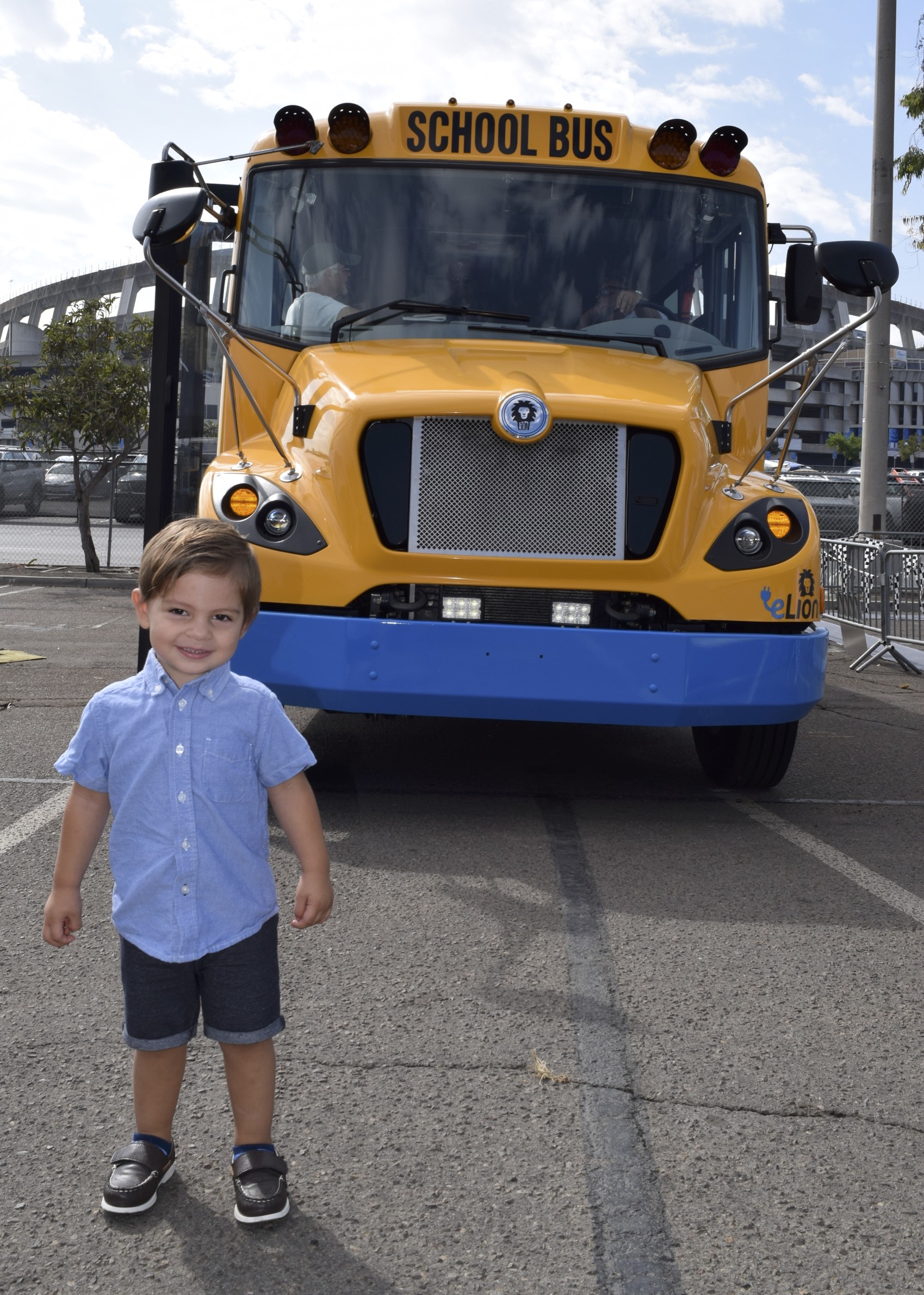For children who ride a school bus, some experiences are pretty universal -- like the long row of brown seats often without seat belts, the impatient driver yelling at kids to sit down, the windows that stick, and of course the awful smell of diesel. It turns out, there could soon be a solution to that last part. Thanks to the billions of dollars now available from the Volkswagen (VW) settlement for all 50 states to invest in clean transportation programs, future generations of school children could be riding in cleaner, quieter, and healthier school buses that are powered by electricity.

Photo Credit: Mary Lunetta
Photo Above: Mary Lunetta's son, Epifanio in front of an electric school bus
After Volkswagen admitted to cheating on diesel-emissions tests, the automaker was forced to pay more than $15 billion, including $2.7 billion to states for investment in plans that reduce harmful emissions from the transportation sector and help offset the 40 times more pollution it illegally dumped into our air.
One of the few specific ways states can choose to invest their funds is by replacing or retrofitting polluting school buses. Children are among the most vulnerable to health impacts from air pollution caused by diesel emissions, in part because of their higher respiration rates but also due to the long bus rides that many children take daily.
States are now designing their mitigation plans, and many are considering using their funds to invest in clean, zero-emission buses to replace their aging fleets. South Carolina wants to replace its 15-year-old school buses; Oregon is looking to replace 450 school buses and is considering adopting electric school buses; Colorado plans to electrify its school buses using about 25 percent of its funds, and Washington State is investing nearly 50 percent of its $112 million into upgrading buses, including school bus fleets. Residents of New Mexico, where it is estimated that 1 in 11 students suffers from asthma and other respiratory problems, recently urged Governor Martinez to invest its VW settlement funds in electric school buses. These are just a few examples, with more expected to be announced in the coming months.
Electric school bus manufacturers include Lion, Starcraft, TransTech, and Blue Bird, which released two electric school bus models just last year. They can travel up to 100 miles on a single charge, which meets student travel needs in most major cities -- the places where we have some of our dirtiest air. As battery efficiency continues to improve, students in rural areas will be able to benefit from clean, zero emission buses, too.
Electric buses are more expensive upfront, but the math shows they are less expensive to fuel and repair than their diesel counterparts. Diesel buses rely on expensive fuel and maintenance, which electric buses don’t need. Higher initial costs for electric school bus adoption are also recouped several times over when their huge benefits to our air and our kids’ health are factored in.
The Sierra Club is collaborating with various community stakeholders and state leaders across the U.S. as states begin to design their plans to spend this clean transportation funding (tens of millions per state). We are advocating that the funds be spent on 1) electric charging stations; and 2) electric school bus, transit bus, and port vehicles. Funds could be spent on compressed natural gas vehicles, diesel retrofits, or propane vehicles, but vehicle electrification is the cleanest type of investment and the wisest choice for states. We are also working to ensure that plans are equitably designed. When state leaders include environmental justice and equity in their investment plans, the communities most impacted by air pollution won’t get left behind in the clean vehicle revolution.
The Sierra Club is working alongside the League of Conservation Voters’ Chispa program’s Clean Buses for Healthy Niños campaign to urge states to invest their VW funds in electric school bus adoption and address the disproportionate impact air pollution has on Latino students. One thing we are noticing in our diverse coalition efforts across the nation is an enormous amount of public interest in the electrification of school bus fleets, regardless of location, political affiliation, or demographics.
Parents, school officials, and environmental groups aren’t the only ones pushing for electric buses -- some utility companies are also advocating for their adoption, including Duke, Indianapolis Power and Light (IP&L), Consumers Energy, and other utilities in the Midwest, through recent pilot and educational programs.
Other regions that have piloted electric school buses includes Massachusetts, which adopted four electric school buses thanks to a grant it jumped on from the Department of Energy Resources (DOER); and Kings Canyon Unified School District in California where there are now four Trans Tech SSTe Type A electric buses in operation. If you’re interested in making the switch to electric school buses in your area, our friends at the Vermont Energy Investment Corporation (VEIC) can help. They’ve developed a number of resources to help you get started.
Some things we can bet on never changing when it comes to school buses. They’ll likely always remain yellow and kids will never stop shoving their chewed gum on the underside of the seats -- but, as we begin to see more electric school buses arrive to transport our children, we’ll see that these clean buses make a difference where it matters most: Cleaning the air for our children and teaching them that a clean transportation future is possible.
To learn more about how to use VW settlement funding for electric school buses, sign up to attend this February 8 LCV Chispa webinar that Mary will be speaking on.